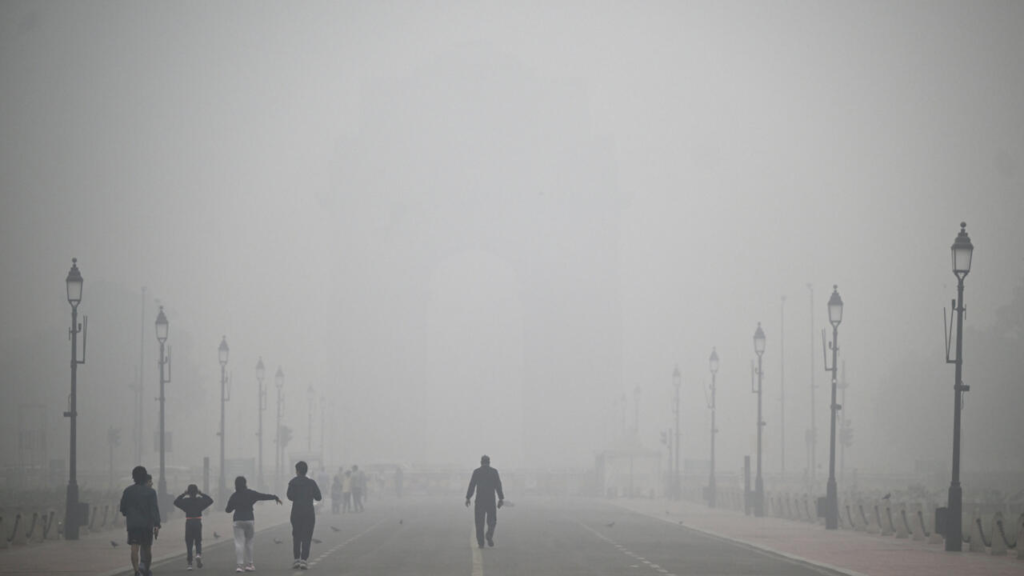Delhi’s Smog Exceeds 60 Times WHO Limit

Dhruv Moondra
17 December 2024
It’s a public health emergency. Not just now but ever since the 2010s. The situation has become so bad that living one day in the city is equivalent to smoking 49 cigarettes, reducing the average life expectancy of a resident by 8.5 years.
What are the factors creating this disaster?
It’s not just one but a multitude of big issues that compound together to make New Delhi worse than a gas chamber.
The city’s pollution gets particularly bad between the months of October and January due to stubble burning and the onset of winter.
During the winter season, cold weather traps pollutants to the ground, establishing a dense layer of smog. This phenomenon occurs as a result of intense pollution that takes place throughout the year. Unfortunately, New Delhi is cursed with added woes that happen during this very period, creating a nightmare.
To further elaborate, during the month of October the city receives a massive wave of smoke and pollutants carried by winds from Punjab and Haryana. These pollutants originate from mass stubble burning from innumerable farms that can worsen Delhi’s air quality by up to 40%.
However despite all this seeming to be very serious, it is just the tip of the iceberg, there are much greater threats to the city that urgently need tackling.
To begin with, vehicular emissions comprise the biggest chunk of the pie, seizing 40% of the total pollution contribution. This is largely due to the sluggish transition to EVs and traffic congestion. In fact, experts say that traffic congestion causes nitrogen oxide emissions to increase by 2.3 times and for EVs, the Delhi government even withdrew subsidies this September, causing a slump in EV sales.
The next biggest source of emissions comes from construction and demolition activities, predominantly because of the amount of dust they produce involving dangerous particulate matter like PM10 and PM2.5. This dust arises from various processes such as excavation, loading and unloading materials, and construction which travel long distances , significantly affecting air quality in surrounding areas. Moreover, demolition activities also release hazardous substances into the air such as asbestos or lead posing serious health risks to anyone nearby. Consequently, it is estimated that covering these sites and construction materials can alone improve air quality by 50%.
Lastly, the most outrageous problem not yet addressed is the fact that most coal power plants still do not have sufficient filters. In fact, all coal power plants in the NCR region emit 3 times more sulfur dioxide than what is legally permitted all while its 33.8 million inhabitants choke in hazardous living conditions. The most concerning part is that there are 11 such coal power plants for every 300 km,when all they need is a special filter. So why is nothing being done?
The pollution in Delhi doesn’t just have a health and environmental impact but also an economic one.
The most obvious is the rise in healthcare costs, as the annual economic burden due to air pollution is close to $1 billion dollars. This puts an immense strain on public healthcare facilities with a big opportunity cost.
Furthermore, the loss in productivity and increased absenteeism is also highly noteworthy since it too costs the Delhi economy $95 billion dollars annually.
Additionally, tourism has also suffered a massive hit especially as the annual smogs coincide with the peak seasons, resulting in a 25-30% drop in foreign tourist arrivals while key events often have to be postponed or cancelled due to health concerns.
Even the retail sector has taken a big hit as many consumers refrain from shopping in person.
With all that being said, what has the government actually done to solve this urgent matter?
Well, regarding the headache of stubble burning the Indian Council Of Agriculture Research(ICAR) has developed an eco-friendly alternative called the Pusa Decomposer which is a liquid that just has to be sprayed onto crops to decompose them into manure.
Why isn’t it working? Because the ICAR is short on funds. The central government only allocates 0.2% of the national budget towards agricultural research compared to 1% in developed countries which aren’t even dependent on agriculture. The outcome is that most farmers are either unaware or are ill informed about the decomposer’s effectiveness and there are no financial incentives being given to reverse the problem.
What’s more, in 2019 India launched the national clean air programme, covering 131 Indian cities to reduce pollution by 40% by 2026. However, the shocking aspect is that governments aren’t even using the money that has been allocated to them. Both Delhi and Noida have used less than 40% of the allocated funds despite being cities that are stifling in pollution.
In Delhi, they have come up with The Graded Response Action Plan (GRAP) with different responses for different ‘grades’ of air quality. These grades are segregated into 5 stages: Stage I – Poor Air Quality (AQI 201-300), Stage II – Very Poor Air Quality (AQI 301-400), Stage III – Severe Air Quality (AQI 401-450), Stage IV – Severe+ Air Quality (AQI > 450).
However these are just temporary measures that don’t solve the underlying issues and therefore have to interfere with the day to day functioning of society and economic activity to keep pollution under control. For instance the GRAP includes restrictions on the vehicles that are allowed to enter certain districts/ the city, the closure of workplaces and educational institutes to work from home and the suspension of certain business activities.
The result has been a 20% decline in annual business activity, especially for small and medium enterprises which substantially widens income inequality. In fact, the ban on all non-essential commercial vehicles have caused the number of vehicles to plummet by 3 to 4 times, crippling trade and tourism.
What must be done to resolve the crises?
Firstly, both the Delhi and Indian government must ramp up their incentives for EVs. So far, EV incentives in India have only summed up to $1.3 billion compared to $72 billion in China and it has been appalling that the Delhi government actually withdrew from EV subsidies when the city so desperately needs them.
Secondly, a relatively easy but effective measure would be to mandate the covering of construction/demolition sites and materials at all times. All it requires is strict monitoring and patrols to keep the industry in check and is anticipated to improve air quality by up to 50%.
The government must also utilise more reliable methods to check and control stubble burning as the current system relies on satellite images that only pass through India for 30 min every day. Besides, more money must be spent on incentivising and promoting alternatives for stubble burning like the Pusa Decomposer as well as on the ICAR so farmers get access to better farming tools and practices.
Finally, the government must take strict action to put in place the right filters onto its coal power plants right away to avoid extreme sulfur dioxide emissions.
Only if the Indian government takes strict action now can it achieve its target of 40% lower pollution by 2026.
Works Cited






Leave a Reply
You must be logged in to post a comment.